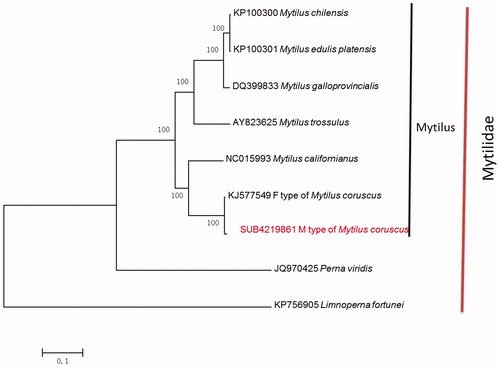Abstract
The complete mitochondrial genome of hard-shelled mussel was sequenced and annotated, it is 16,625 bp in length and contains 12 protein-coding genes (ATP8 is absent, as in most species in Mytilus), two ribosomal RNA genes and 22 transfer RNA genes. The content of A + T (63.2%) base pairs was higher than that of the G + C (36.8%) base pairs in the mitochondrial genome sequences, which indicated that the base composition is biased. Phylogenetic analysis based on neighbour-join of the twelve protein-coding genes showed that M. coruscus has closer relationships with M. californianus, which indicated that M. coruscus belongs to the Mytilidae family. This work provides general information on the evolution of cultured Mytilidae.
Mytilus coruscus is an important economic shellfish among aquatic invertebrates along the eastern coast of China, especially in Zhoushan (China) coast. Mitochondrial DNA (mtDNA), a relatively independent extracellular genetic material in the cell, is widely distributed in various tissues and cells, and is easily separated and purified (Rawson and Hilbish Citation1995; Śmietanka and Burzyński Citation2017). In contrast to most animal species, where mitochondria are maternally inherited, Mytilus mussels have an unusual system of mitochondrial DNA (mtDNA) transmission, termed doubly uniparental inheritance (DUI) (Skibinski et al. Citation1994; Zouros et al. Citation1994). Under DUI, females have only one, female (F) mtDNA inherited from their mothers, whereas males are heteroplasmic with an additional male (M) mtDNA inherited from their fathers (Passamonti and Scali Citation2001). The F mtDNA of hard-shelled mussel has been discovered by Lee (Lee and Lee Citation2014), however, whether the M mtDNA certainly existed in M. coruscus? No report recorded it yet, therefore, the objective of this research is to make it sure and determine the complete M mtDNA sequence of M. coruscus, which will help understand the evolutionary history and phylogenetic relationship of the Mytilus species in the family Mitilidae.
The adult M. coruscus (5–8 cm in length) were collected from Zhoushan seafood market, Zhejiang Province, P. R. China, preserved in Zhejiang Ocean University Museum with the accession number 20170821Mc20. The genomic DNA was extracted from the gonad tissue. Ten large fragments were amplified by long PCR accordingly. Through primer walking sequencing and sequence assembly, the complete mitochondrial DNA sequence of 16,625 bp was obtained.
The M type mitogenome of M. coruscus (GenBank accession number SUB4219861) is a circular molecule of 16,625 bp which contains 12 protein-coding genes (PCGs), two rRNA genes (including 12S ribosomal RNA and 16S ribosomal RNA), 22 transfer RNA genes(tRNA), and a control region (D-loop). Calculate the base frequency of mitochondrial DNA with the nucleotide composition option in MEGA6.0 software statistics. The overall nucleotide composition is 28.1% A, 23% G, 35.1% T and 13.8% C, the content of A + T (63.2%) base pairs was higher than that of the G + C (36.8%) base pairs in the mitochondrial genome sequences, which indicating that the base composition is biased. All protein-coding genes but ND1 (ATA) and ND5 (ATT) using ATG as the start codon; TAA, TAG (ND4) and TA- (ND5) are found as stop codons. All tRNAs harbour the clover leaf secondary structures predicted by tRNAscan-SE (Schattner et al. Citation2005) except for the tRNA-Ser (AGN) and tRNA-Ser (UCN) lacking the dihydrouidine arm (DHU-arm).
The phylogenetic tree () was constructed by neighbour-joining (NJ) methods using mitochondrial genomes PCGs of 8 Mytilidae species. The phylogenetic analysis of all complete mitochondrial genomes available from Mytilidae mussels confirmed the close evolutionary relationships among bivalves from the genus Mytilus. Meantime, the tree supported clear phylogenetic relationships between the F type of hard-shelled mussel (Lee and Lee Citation2014) and the M type of hard-shelled mussel, compare to the discovery. However, there is not a distinct difference.
Disclosure statement
No potential conflict of interest was reported by the authors.
Additional information
Funding
References
- Lee YC, Lee YH. 2014. The F type mitochondrial genome of hard-shelled mussel: Mytilus coruscus (Mytiloida, Mytilidae). Mitochondrial DNA. 27:624–625.
- Passamonti M, Scali V. 2001. Gender-associated mitochondrial DNA heteroplasmy in the venerid clam Tapes philippinarum (Mollusca Bivalvia). Curr Genetics. 39:117–124.
- Rawson PD, Hilbish TJ. 1995. Evolutionary relationships among the male and female mitochondrial DNA lineages in the Mytilus edulis species complex. Mol Biol Evol. 12:893–901.
- Schattner P, Brooks AN, Lowe TM. 2005. The tRNAscan-SE, snoscan and snoGPS web servers for the detection of tRNAs and snoRNAs. Nucleic Acids Res. 33:W686.
- Skibinski DOF, Gallagher C, Beynon CM. 1994. Mitochondrial DNA inheritance. Nature. 368:817–818.
- Śmietanka B, Burzyński A. 2017. Disruption of doubly uniparental inheritance of mitochondrial DNA associated with hybridization area of European Mytilus edulis and Mytilus trossulus in Norway. Marine Biol. 164:209.
- Zouros E, Ball AO, Saavedra C, Freeman KR. 1994. Mitochondrial DNA inheritance. Nature. 368:818.

